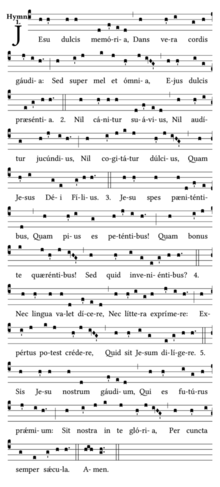Jesu dulcis memoria
Jesu dulcis memoria (“O dear Jesus, I think yours”) is a Latin hymn from around 1200 . The text was dedicated to St. Attributed to Bernhard von Clairvaux , which is why he was also called Jubilus Sancti Bernhardi or Des heiligen Bernhard Freudengesang in the Baroque era . Many composers have set the hymn to music. Your own Gregorian gave him the Roman antiphonal from 1912. This melody is included in the praise of God with a German adaptation by Friedrich Dörr (No. 368).
Lore history
The hymn has been handed down in various manuscripts since the 12th century. The number of stanzas varies between 42 and 53. From these three sections, each with five stanzas, were selected for the office on the feast of the Holy Name of Jesus , which was celebrated until the liturgical reform on Sunday between New Year and Epiphany : Jesu dulcis memoria at Vespers , Jesu rex admirabilis for Matutin and Jesu decus angelicum for laudes .
The poem is related to the Jesus mysticism of St. Bernhard von Clairvaux close. The historical and linguistic findings make his authorship unlikely.
Content and form
The hymn is a meditation on the consolation experienced and the longing for the presence of Jesus.
The stanza form is the Ambrosian hymn stanza of four eight-syllable lines. The predominant rhyming scheme is[aaaa].
Text and translation
|
Jesu dulcis memoria, |
The memory of Jesus is sweet, |
|
Nil canitur suavius, |
Nothing is more beautiful to sing, |
|
Jesu spes paenitentibus, |
Jesus, hope for the penitent, |
|
Nec lingua valet dicere, |
The tongue cannot say it |
|
Sis Jesu nostrum gaudium, |
Be, Jesus, our joy, |
reception
As the Jubilus Sancti Bernhardi , the hymn was also highly valued in Lutheran orthodoxy and early Pietism . This is evidenced by the numerous adaptations and new creations inspired by his role model by Martin Moller , Johann Heermann , Benjamin Prätorius , Heinrich Müller , Christian Knorr von Rosenroth and others.
literature
- Hugh Henry: Jesu Dulcis Memoria . In: Catholic Encyclopedia , Volume 16, Robert Appleton Company, New York 1914.
Web links
Individual evidence
- ↑ Choral Public Domain Library ; Because of the common stanza scheme, the text is often underlaid to existing compositions.
- ↑ Jesu rex admirabilis , Latin and English
- ↑ Jesu decus angelicum , Latin and English
- ↑ In Gotteslob (2013) “Oxford 12th century” is given as the texture jump. The Catholic Encyclopedia (1914) reports individual hymnologists on alleged manuscript finds and attributions, etc. a. to an 11th century Benedictine abbess.
- ^ Albrecht Ritschl : History of Pietism in the Lutheran Church of the 17th and 18th centuries . Bonn 1884, p. 64
- ↑ Jeung Keun Park: Johann Arndts Paradiesgärtlein: An investigation into the origins, sources, reception and effects . Göttingen 2018, p. 218
